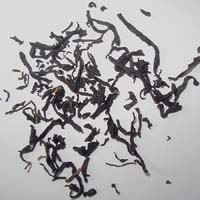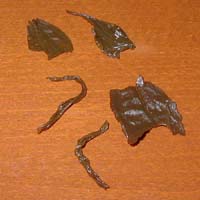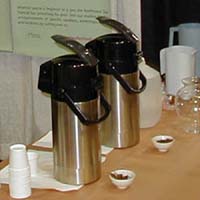At some point over the last couple of months, I received a sample of tea. Unfortunately, between then and now, the label got sticky or damp or something and stuck to my counter. When I picked it up to brew it, all I could manage to make out was “near Guangzhou.” I know it’s a red (black) tea, and that it’s from a place near Guangzhou, but that’s it.
 Anyway, since I haven’t had a black tea made in Guangdong province (a.k.a. Canton) to the best of my knowledge, I thought I’d give this one a try. By the way, Guangzhou is the capitol city of Guangdong province. I’m trying to stay away from tea-tasting reviews on this blog since that’s the focus of most other tea blogs, but I’m making an exception for this tea for the simple reason that it’s a new province/tea-family combo for me.
Anyway, since I haven’t had a black tea made in Guangdong province (a.k.a. Canton) to the best of my knowledge, I thought I’d give this one a try. By the way, Guangzhou is the capitol city of Guangdong province. I’m trying to stay away from tea-tasting reviews on this blog since that’s the focus of most other tea blogs, but I’m making an exception for this tea for the simple reason that it’s a new province/tea-family combo for me.
The dry leaf had lots of long, thin leaf twists that appeared to be whole leaves. It reminded me of a larger size of, say, Keemun Mao Feng or a Ruby #18 from Taiwan. Balancing that were a number of smaller-sized pieces (which could have happened anywhere from the processing to me yanking the bag off the counter).
 I brewed 2.5g in a 150ml ISO-standard tasting pot, using a 3-minute steep in freshly boiled water. The source of the water was Seattle tap water, filtered through a Brita pitcher. (Not that it matters, but I boiled the water in a stainless steel electric kettle.) When the brewing was complete, I presented it as if I were doing a flight of tea samples and took a picture. They don’t call me a tea geek for nothing.
I brewed 2.5g in a 150ml ISO-standard tasting pot, using a 3-minute steep in freshly boiled water. The source of the water was Seattle tap water, filtered through a Brita pitcher. (Not that it matters, but I boiled the water in a stainless steel electric kettle.) When the brewing was complete, I presented it as if I were doing a flight of tea samples and took a picture. They don’t call me a tea geek for nothing.
As you can see from the picture, the liquor color was an amber-caramel color, which could either mean that it was under-brewed, or that this particular tea simply has more theaflavins than thearubigins (the colorful antioxidants that are in red/black tea but not so much in green tea.)
The scent of the liquor was a little nondescript. I got the impression of black tea, of course, but not much character beyond that. Nothing bad, just nothing fantastic either.
 Remember how I said the leaves reminded me of the Taiwan black tea Ruby #18? Well, the flavor was like that also–on the lighter end of black tea flavor. Only trouble was that where Ruby #18 has a sweet smoothness, Near Guangzhou had a little bite to it instead. Again, not unpleasant but not very complex or interesting. I imagine this tea to be a reasonable everyday tea–one you’d have with something, not as the center of attention. Maybe a better description of the flavor would be if you took Ruby #18 and cut it with a low-grade Keemun.
Remember how I said the leaves reminded me of the Taiwan black tea Ruby #18? Well, the flavor was like that also–on the lighter end of black tea flavor. Only trouble was that where Ruby #18 has a sweet smoothness, Near Guangzhou had a little bite to it instead. Again, not unpleasant but not very complex or interesting. I imagine this tea to be a reasonable everyday tea–one you’d have with something, not as the center of attention. Maybe a better description of the flavor would be if you took Ruby #18 and cut it with a low-grade Keemun.
The infusion shows longish (1-2″) twisted leaves. Untwisting pieces revealed generally between 50% and 75% of a whole leaf. My guess is that whole leaf was the goal of processing, but many were broken in processing or while dry. They had a pleasant-yet-plain chocolate brown color.
My overall take, then, was that it was fun to try out, but I’m not going to kill myself tracking down where this sample came from so I can get some more.
 It’s been a bit since I wrote last, in part because of the Thanksgiving holiday, but more because of the Seattle food & Wine Show. If you’re subscribed to my newsletter, you’ll know that I did a bunch of work helping set up a booth at this show for the Puget Sound Tea Education Association (PSTEA). That’s what’s taken up much of my time over the last couple of weeks, but I can say that it was a success. Our goal was to let people know that we’re working on the first Northwest Tea Festival, and to start building our mailing list.
It’s been a bit since I wrote last, in part because of the Thanksgiving holiday, but more because of the Seattle food & Wine Show. If you’re subscribed to my newsletter, you’ll know that I did a bunch of work helping set up a booth at this show for the Puget Sound Tea Education Association (PSTEA). That’s what’s taken up much of my time over the last couple of weeks, but I can say that it was a success. Our goal was to let people know that we’re working on the first Northwest Tea Festival, and to start building our mailing list. We had almost 30 tea businesses involved in the discussion and planning, and a dozen or so who contributed to the supplies, advertising, booth staffing, tea samples, and everything else we needed to get the booth up and running. We answered questions, showed off a real live tea plant from Russia, handed out sample cups of tea, and gave out punch cards for samples from local tea shops to those who joined our mailing list.
We had almost 30 tea businesses involved in the discussion and planning, and a dozen or so who contributed to the supplies, advertising, booth staffing, tea samples, and everything else we needed to get the booth up and running. We answered questions, showed off a real live tea plant from Russia, handed out sample cups of tea, and gave out punch cards for samples from local tea shops to those who joined our mailing list.


